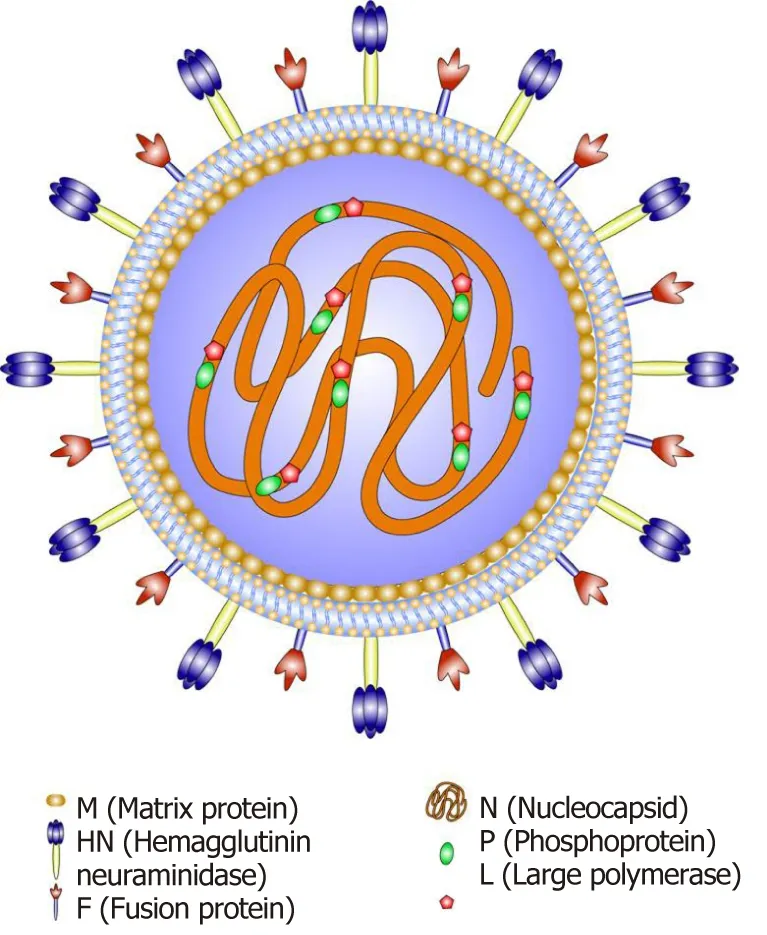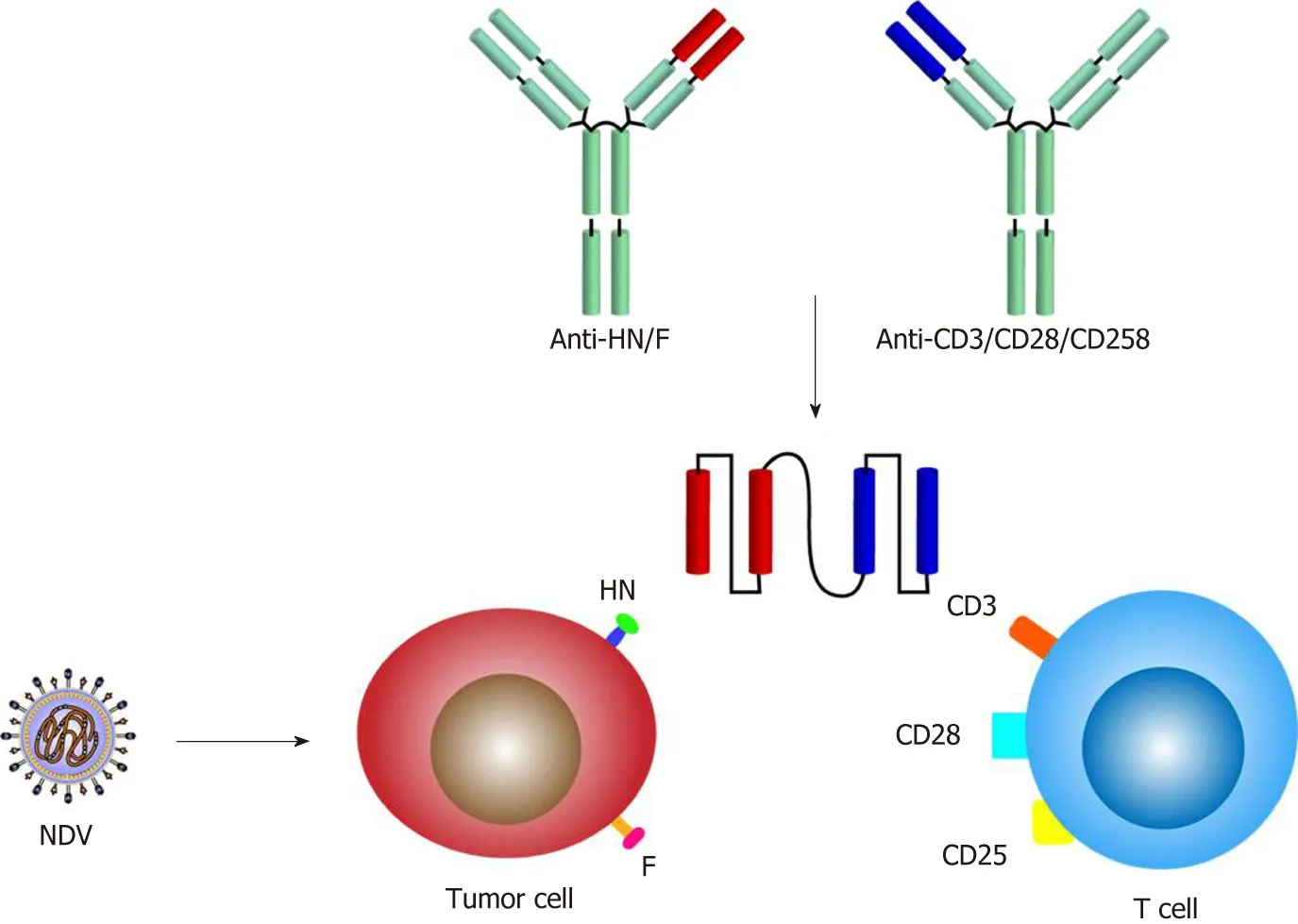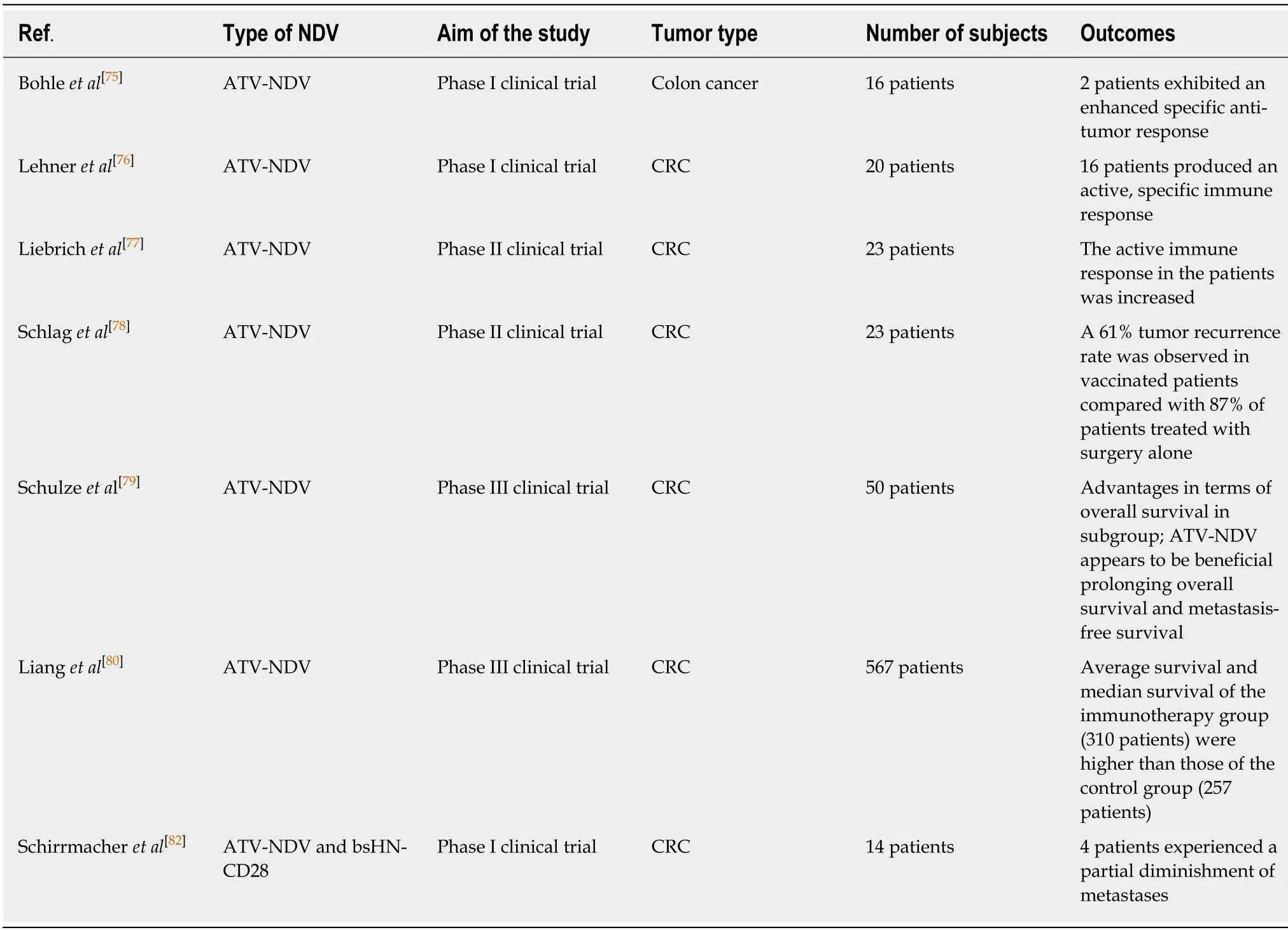Application of Newcastle disease virus in the treatment of colorectal cancer
Hui Song, Li-Ping Zhong, Jian He, Yong Huang, Yong-Xiang Zhao
Abstract
Key words: Newcastle disease virus; Exogenous gene; Armed virus; Oncolytic therapy;Colorectal cancer
INTRODUCTION
Colorectal cancer (CRC) is one of the main causes of global cancer death, and its incidence continues to rise[1].At present, surgery and chemotherapy are still the main treatments for CRC.About one-third of patients with CRC will have metastatic tumors of the liver or lung, making their 5-year overall survival rate only 50%[2].Similar to many other malignancies, CRC is a heterogeneous disease, therefore optimizing treatment and reducing related mortality is the main challenge.In the current treatment of tumors, in addition to traditional surgery, radiotherapy and chemotherapy, immunotherapy has become a very hot field, which mainly includes oncolytic virus[3], tumor vaccine[4], targeted therapy[5], immune cell therapy[6]and immunological checkpoint inhibitors[7].With the development of genetic engineering and the application of molecular biology, the treatment of CRC with oncolytic virus has been rapidly developed in recent decades, and genetically modified viruses have been used to evaluate the efficacy of anti-CRCin vitroandin vivo.
NEWCASTLE DISEASE VIRUS (NDV)
Molecular biological characteristics of NDV
NDV is a highly infectious avian pathogen[8]that is an avian paramyxovirus type I virus, and a member of the genusAvulavirusin the family Paramyxoviridae[9].NDV is a bilayered, lipid-coated RNA virus of approximately 100-300 nm with a predominantly spherical morphology.The genome of NDV is a nonsegmented negative-sense, single-stranded RNA [ssRNA(-)] molecule consisting of 15186 nucleotides containing six open reading frames encoding six structural proteins:nuclear protein (NP), phosphoprotein (P), large polymerase protein (L), matrix protein (M), hemagglutinin-neuraminidase (HN) and fusion protein (F).Among its structural proteins, NP, P and L combine with the viral RNA to form the ribonucleoprotein complex, which is responsible for replication of the virus[10](Figure 1).M comprises a layer underneath the viral membrane that is involved in the assembly and budding of the virus.HN and F are present as oligomers, which together with the lipid bilayer membrane of the host constitute the outer envelope of the virus and are involved in entry of the virus into a cell.F is typically present as the inactive polypeptide F0; cleavage produces the mature membrane-anchored F1 and the membrane-distal F2 domain, resulting in an infectious virus[11].

Figure 1 Molecular structure of Newcastle disease virus.
The HN protein of NDV can trigger a conformational change in the F protein through receptor sialic acid-mediated endocytosis to release the fusion peptide and promote fusion of the virus with the cell membrane and allow the ribonucleoprotein complex to enter the cytoplasm of a host cell[12].The genome replicates in the cytoplasm[13]:(1) The genomic ssRNA(-) is transcribed into messenger RNA in the cytoplasm for translation into different structural proteins; (2) The antigenome copy,or ssRNA(+), is used as the template for viral genome amplification, and subsequent budding releases virus progeny[14]; and (3) HN can scavenge sialic acid residues and promote spread of the virus in infected tissues.Selective replication of the virus results in host cell lysis only in tumor cells[15,16,17]with replication that is 10000 times faster than that in most normal human cells.Viral replication is terminatedviathe defense mechanisms of interferon (IFN) in normal cells[18].In contrast, tumor cells usually have a weak type I IFN response and are also less sensitive to type I IFN receptor-mediated signaling; therefore, use of NDV in cancer patients is safe.The frameshift variant protein V is formed during transcription of the P gene.V participates in the antiviral reaction in avian cells, whereby the inhibition of IFN induction by NDV is suppressed by reduced stimulation of IFN-β through degradation of signal transduction and activator of transcription 1viainteractions with avian cell proteins[19].This response occurs because the immune escape mechanism functions only in birds and not in mammalian cells.Therefore, it appears that the V protein reduces the range of NDV hosts.
NDVs are usually divided into three types according to pathogenicity and virulence:Velogenic strains (virulent strains, strongly toxic), mesogenic strains(poisonous strains, moderately toxic), or lentogenic strains (attenuated strains, poorly toxic or nontoxic)[20].These viruses are also divided into two groups based on the degree of their influence on tumors:(1) Oncolytic strains that form syncytia in tumor cells and have viral oncolytic activity eitherin vitroorin vivo; and (2) Nononcolytic strains that inhibit tumor growth and can increase survival, though their killing effect on human tumor cells is still unclear.In general, the site of F protein cleavage mainly determines the virulence of NDV.The F-cleavage site of velogenic and mesogenic strains usually has the polybasic amino acid structure112R/G/KR-Q/KK/RR↓F117,which is recognized and cut by Folin-like proteases (RXK/RR), inducing deadly respiratory diseases (such as chicken mites) in birds[21]; examples include MTH-68/H,PV701 and Beaudette C.In contrast, lentogenic strains have the single amino acid motif112GR/KQGR↓L117, which is cleaved by extracellular trypsin-like proteases; thus,replication is limited to specific tissues, and these strains are currently used.For the production of vaccines[22], such as NDV-LaSota and NDV-HUJ, Heidenet al[23]constructed a recombinant attenuated strain of NDV clone-30.When the F-cleavage site was altered, the intracerebral pathogenicity index was enhanced 1.2-fold.Overall,NDV virulence is related to the site of F cleavage and is regulated by multiple factors.
Although NDV is dangerous to many birds, its pathogenicity in humans is weak.Furthermore, most people are seropositive for NDV, and thus the immunogenicity that NDV may cause can be ignored.Under natural conditions, highly virulent NDV strains may infect humans but cause only mild fever, cough and other flu-like symptoms.
The oncolytic mechanism of NDV
The cells of various human tumors, such as liver cancer[24], glioblastoma[25]and lymphoma[26], have been shown to be sensitive to NDV.In addition, because NDV RNA transcription and translation are not related to cell proliferation, the virus can target tumor stem cells, dormant tumor cells, and X-ray-irradiated vaccine tumor cells[27].
The oncolytic mechanism of NDV mainly include the following aspects.First, the virus selectively infects and replicates in tumor cells.Second, indirect effects of the innate and adaptive immune responses of the host immune system act against the virus, involving natural killer (NK) cells and cytotoxic T lymphocytes targeting the antigen[28,29].Third, the envelope protein also participates in the oncolytic effect.Fourth, the apoptotic pathway promotes the oncolytic effect.Fifth, the virus induces immunogenic death, necrosis and autophagy (Figure 2).
The NDV envelope protein participates in oncolytic effects
Studies have found that a variety of proteins of NDV can impact infected cells, and protein sequence characterization also revealed that M, L and F have a BH-3 domain that shows homology with the proapoptotic factor Bcl-2[30].Among these proteins, HN is an important immunogenic protein and virulence factor.Indeed, it has been reported that despite weaker efficacy than the parental NDV AF2240 strain, HN gene expression alone was able to induce apoptosis in human breast cancer MCF-7 cells[31].HN induces release of type I IFN from human peripheral blood mononuclear cells and up-regulates expression of tumor necrosis factor (TNF)-related apoptosisinducing ligand (TRAIL)[32].Heet al[33]constructed a novel oncolytic adenovirus containing the human telomerase reverse transcriptase (hTERT) promoter and expressing the HN protein of NDV (Ad-hTERTp-E1a-HN) that selectively inhibits esophageal cancer EC-109 cells and inhibits tumor growth in mice.In addition,studies have indicated that the M protein of NDV AF2240 strain binds to Bax through its BH-3 domain to promote the transfer of Bax from the cytoplasm to the mitochondrial membrane, thereby activating the intrinsic apoptotic pathway[34].
The IFN system affects oncolytic activity
NDV stimulates the body's immune system to produce a variety of cytokines with anti-tumor activity, such as various IFNs or TNF.Type I IFN exerts a direct antitumor effect by targeting tumor cells and tumor stem cells and can indirectly stimulate immune system activity to assist in tumor killing.The recombinant NDV obtained by inserting the influenza virus NS1 gene, which antagonizes the IFN system in mammalian cells, into the NDV Hitchner-B1 genome promoted apoptosis in human tumor cell lines and the B16 melanoma mouse model with enhanced oncolytic effects[35].
An apoptotic pathway is involved in the NDV oncolytic effect
Some studies have shown that the oncolytic effect of NDV is related to the various apoptotic pathways of cells, and the apoptosis induced by NDV requires viral replication and expression of apoptotic proteins.
The exogenous apoptosis pathway is mainly mediated by the death receptor Fas and its ligands FasL and TRAIL.For example, due to overexpression of Fas, the recombinant attenuated strain rNDV-B1/Fas exhibited enhanced oncolytic abilityin vitroandin vivo, which resulted in an earlier and stronger apoptotic response in infected cells[36].Compared to the wild-type virus, Bai's recombinant virus, LaSota-TRAIL[37], increased expression of TRAIL by 3-fold.In a mouse experiment, the LaSota-TRAIL group displayed significantly increased survival and decreased tumor recurrence.Other studies have indicated that due to overexpression of the inhibitor of apoptosis protein Livin in tissues of stage III melanoma, advanced melanoma is more susceptible to the NDV-HUJ virus than is an early-stage tumor[38].Up-regulation of the apoptosis inhibitory protein survivin prolongs the viability of human breast cancerresistant cells infected with the NDV AF2240 strain and increases viral protein synthesis as well as viral replication[39].
NDV causes immunogenic cell death
One immunotherapy mechanism of oncolytic viruses is immunogenic cell death(ICD)[40].The manner in which NDV induces ICD in tumor cells includes immunogenic apoptosis, necrosis and pyroptosis, with termination of protein synthesis and subsequent exposure to calreticulin, heat shock proteins and the viral proteins HN and F.
Under endoplasmic reticulum stress, accumulation of unfolded proteins or misfolded proteins in the endoplasmic reticulum can cause the unfolded protein response, a specific response in NDV-infected cells.Activation of the unfolded protein response triggers caspase 12-induced cell death.Moreover, Chenget al[41]demonstrated that the structural proteins NP and P induce autophagy through the endoplasmic reticulum stress pathway.

Figure 2 The main anti-tumor mechanisms and consequences of NDV infection of tumor cells.
The corresponding pattern recognition receptors of innate immune cells include cytoplasmic RIG-1, PKR, TLR and NKp46.The pathogen-associated molecular pattern of NDV involves the virus 5’-adenosine triphosphate leader RNA, dsRNA and HN protein.Pattern recognition receptors trigger a variety of immune responses,including induction of type I IFN responses, promotion of immune cell activation and release of immune factors.In a mousein situglioma model, NDV virus therapy and molecules such as calreticulin, heat shock proteins and high mobility group protein-1 were found to induce ICD, stimulating specific immune T cells.Additionally,interaction between RIG-1 and RNA simultaneously activated type I IFN and induced IL-1β production.The double-stranded RNA of NDV induces expression of TLR-3,FN-α and heat shock proteins, which promotes tumor cell apoptosis and inhibits tumor growth by enhancing the immune system response.NKp46 of NK cells recognizes viral HN proteins and transmits cytotoxicity-inducing signals, increasing production of IFN-α and TRAIL.After NDV infection of monocytes and NK cells, IL-2, IFN-γ, GM-CSF and TNF-α are produced to promote tumor-killing activity through TRAIL[42,43].
Viral infection of tumors can promote an immunosuppressive environment by inducing immune cytokines and chemokines (RANTES and IP-10)[44].Although cytokines and chemokines recruit and activate neutrophils, NK cells, macrophages and CD4+and CD8+T lymphocytes, contributing to viral clearance, these molecules also alter immunosuppression.HN molecules on the surface of infected tumor cells increase the cell adhesion strength of lymphocytes and T cells for T cell costimulation.As the first responder of innate immunity, neutrophils cause the release of the chemokines CXCL1, CCL2 and CXCL10, thereby mediating immunogenic cell death[45].
NDV induces programmed cell death, necrosis and autophagy
After NDV infection of cells, the accumulation of HN and F proteins on the host cell surface promotes the formation of cell syncytia and lead to cell-to-cell fusion, which ultimately triggers necrosis, syncytium disintegration, content release and an inflammatory response.Cell necrosis is also activated by caspase 8 through the cellular TLR and the TNF family.
The HN and F proteins of NDV rapidly induce syncytium formation and initiate stable autophagy fluxes in lung adenocarcinoma cells (A549), synergistically inducing autophagosome fusion with lysosomes for cell degradation[46].Autophagy is beneficial for viral replication in the early stages of NDV infection of tumor cells and lengthens the cell life cycle by regulating apoptosis.Mitochondrial autophagy has been reported to promote oncolytic NDV replication by breaking the intrinsic apoptosis regulation pathway in lung adenocarcinoma cells[47].Several ongoing trials are evaluating the impact of autophagy on human tumor therapy[48].For example, Huet al[49]found that NDV-infected U251 cells can promote autophagy to degrade lung cancer cells.The autophagy regulators chloroquine and rapamycin significantly enhanced the oncolytic effect of NDV on A549 cells in mice[50].This finding provides a new idea for exploring the antitumor strategy utilized by autophagy regulators and NDV.
Extracellular matrix molecules in solid tumor tissues affect cell migration and invasion
NDV treatment in different metastatic tumor models has revealed a blockade effect on tumor migration and invasion.Studies have shown that the NDV strain AF2240 can reduce the migration ability of breast cancer cells by directly inducing a decrease in cell proliferation[51].In addition, oral squamous cell carcinoma was infected with the NDV D90 strain, and a correlation between apoptosis induction and cell migration was observed[52].Studies have shown that simultaneous injection of NDV,extracellular matrix-degrading enzymes, collagenase and heparanase into a tumor can increase spread of the virus in tumor tissue, thereby enhancing the oncolytic effect[53].However, because proteolytic enzymes are involved in tumor metastasis and their inhibitors have been used to suppress metastatic tumors, it is not known whether application of virus loading of a matrix metalloproteinase is feasible in the clinic.
NDV IN THE TREATMENT OF CRC IN VITRO AND IN MICE
The NDV strains currently used in mouse experimental models and clinical tests include pathogenic (MTH-68/H, Ulster and PV701) and nonpathogenic (Hitchner-B1,LaSota, 73-T and HUJ) strains[54].NDV has been shown to have potent anti-tumor effects against colon tumors[55], hepatocellular carcinoma[56]and melanoma[57].
The appeal of viral vectors is related to their broad host cell range and high expression levels of foreign genes.Typically, viral vectors with a DNA or RNA genome can be loaded with foreign genes of different lengths; for example, most vectors allow insertion of 6-8 kb, including extensive therapeutic genes[58].Recently,reverse genetics technology has been applied to help produce recombinant NDV(rNDV) from nonsegmented negative-strand RNA-cloned cDNA to enhance oncolysis[59], as follows:Mutating the F gene[60]; inserting a gene encoding a cytokine,such as IL-2[61], IL-15[62]or IL-7[63], to enhance the immunostimulatory effect;simultaneous insertion of two cytokines synergistically to increase antitumor effects[64]; and inserting a bispecific antibody consisting of a single-chain variable region that can simultaneously target virus and immune cells.Concerning T cells, the targets can be CD3, CD25 and CD28, whereas the target of NDV can be F or HN[65](Figure 3).
Chiaet al[66]incubated with human NDV strain AF2240in vitrowith human CRC cell lines (SW620, ddd-1, Dks8, HCT116p53+/+, HCT116p53-/- and HT29).Cell death occurred in 70-90% of cells after 96 hours of culture, providing a basis forin vivoexperiments.In one study, a nude mouse model of human colon cancer SW620 cells was established, and the anti-tumor effect was studied by intratumoral and intravenous injection using NDV Mukteshwar strain.The results showed that tumor growth in mice was inhibited by 43% and 40%, respectively, and the survival time was prolonged[55].
In the subcutaneous model of BALB/c mice bearing CT26 colon cancer, NDV Ulster strain was injected in and around the tumor after tumor inoculation, and the tumor was completely relieved by the 40th day.The long-term survival rate was 70%[67].When NDV was used for local treatment of liver metastases of MTH-68/HCT26 colon cancer cells, it was observed that tumor growth was significantly inhibited, the survival time of mice was prolonged, and there was no toxic side effect on mice[68].Ockertet al[69]constructed a tumor-bearing mouse model of human colon cancer(SW620, HT29 and MM17387) and injected intratumoral and intraperitoneal injections with NDV 73-T strain.The results showed that multi-dose NDV injection significantly inhibited tumor growth in mice compared with single dose, and the inhibition rate reached 77-96%.
Vigilet al[70]treated the constructed CT26 colon cancer mouse model with the NDV recombinant strain rNDV/F3aa-IL-2 expressing IL-2.Compared with the wild-type control virus, the recombinant virus can significantly reduce the tumor growth of the tumor-bearing mice and prolong the survival time, so that the condition of most mice is sustained.Yamakiet al[71]established CRC multifocal liver metastasis model of rats or multifocal lung metastasis model using the expression of mutant (L289A) new town of fusion protein of soluble tumor cystic stomatitis virus carrier (types) [rVSV NDV/F (L289A)][72]for hepatic artery and local drug delivery.The pulmonary metastasis models did not show long-term survival.However, in the mice liver metastasis model, four of the seven rats survived for more than 100 d.This result provided an effective basis for the follow-up clinical trials.

Figure 3 Bispecific antibodies consisting of single-chain variable regions can be simultaneously targeted to viruses and immune cells.
CLINICAL APPLICATION OF NDV AGAINST CRC
The application of NDV tumor therapy has entered the clinical phase (phases I, II and III)[73], and three methods are generally used in clinical trials:(1) Injection of infectious virus alone; (2) Injection of intact tumor cells infected with NDV; (3) Injection of the protein lysate of NDV-infected tumor cells; and (4) Combined use.As NDV infection of tumor cells can lead to enhanced immunogenicity, an autologous tumor vaccine(ATV-NDV) can be constructed using the tumor cells of a patient[74], and clinically postoperative activity-specific immunotherapy has been performed for patients with CRC (Table 1).
Some phase I-IV clinical trials based on NDV vectors have yielded encouraging results.For the first time, Bohleet al[75]treated 16 patients with colon cancer after tumor resection with a live, nontoxic NDV-modified tumor cell vaccine.Of the 16 patients, 12 patients had an enhanced specific anti-tumor response.In a phase I clinical trial, 20 patients with CRC were treated with ATV-NDV-specific immunotherapy, with the exception of four patients with mild fever and no serious side effects.Among them, 16 patients produced an active specific immune response to the vaccine, which provided effectiveness for subsequent clinical trials[76].
Liebrichet al[77]isolated tumor cells from human primary CRC and mixed vaccine with NDV nonlytic strain Ulster and used it for vaccination in 23 patients with colorectal liver metastasis.The results showed the active immune response in the patient is increased and can be further used in related tests.In a phase II clinical trial,23 patients with liver metastases from CRC were completely resected after a consecutive 3 mo of ATV-NDV vaccination.At least 18 mo follow-up showed a 61%tumor recurrence in vaccinated patients compared with 87% of patients who underwent surgery alone[78].In a prospective randomized phase III trial, 50 patients with CRC hepatic metastases were randomized into an experimental group and a control group.The experimental group received six doses of ATV-NDV.After approximately 10 years of follow-up, no differences in primary and secondary endpoints were detected in the total patient group.However, the experimental subgroup (13 patients with colon cancer) showed significant advantages in terms of overall survival.The vaccination appeared to help prolong overall survival and metastasis-free survival[79].
In a phase III trial, Lianget al[80]used ATV-NDV to treat 335 patients with stage I-IVCRC.The average survival and median survival of the immunotherapy group (310 patients) were higher than those of the control group.The other 25 patients with advanced disease had a 1-year survival rate of 96%.The total effective rate of immunotherapy was 24%.After NDV vaccine immunotherapy, the number of NK cells increased, and the immune function improved significantly.In patients with stage IV colon cancer, tumor memory T cells (MTCs) may induce tumor-associated antigens either spontaneously or upon vaccination with an antitumor vaccine, which may constitute a potential mechanism in those patients with long-term survival[81].

Table 1 Summary of clinical studies using NDV in CRC
Multiple immunizations of colon cancer patients with ATV-NDV using CD3 or CD28 on HN or F and T cells simultaneously targeting the virus have been shown to be clinically effective and improve long-term survival[82].Attachment of the NDVspecific single-chain antibody anti-HNxanti-CD28 (bsHN-CD28) to ATV-NDV enhances T cell costimulatory signals.After using ATV-NDV-bsHN-CD28 to treat 14 cases of advanced CRC not surgically treatable in the phase I clinical trial, no tumorreactive blood circulation MTCs were detected in any of the patients before vaccination; however, all patients exhibited the immune response of tumor-reactive MTCs at least once during five vaccinations.Among them, four patients experienced partial diminishment of metastases[83].
NDV-based treatment causes only mild pus-like symptoms, and these side effects are temporary and well tolerated; even high dosesviaintravenous administration did not cause significant toxicity.Although rNDV treatment may lead to some side effects, the response is negligible when compared to the therapeutic effect.When a patient is initially desensitized with a lower dose, the subsequent maximum tolerated dose may be increased by a factor of ten[84].
DISCUSSION
The multiple preclinical data and clinical trials with oncolytic NDV clearly demonstrate its efficacy for CRC.However, there are several questions that need to be resolved .One of the key issues in oncolytic therapy is targeted delivery[85].Moreover,the extracellular matrix and other barriers in solid tumors may interfere with and slow viral transmission, thereby reducing oncolysis.
In addition, due to the induction of neutralizing antibodies, the oncolysis effect of the virus after repeated viral administration may decrease over time[86].To overcome the potential neutralizing effect of the antibody on the virus, an aptamer was used to block the antibody, thereby preventing neutralization of the virus.Furthermore,treatment with a paramyxovirus mesenchymal stem cell vector protects the virus against neutralizing antibodies with efficient transfer of the virus to the tumor.
In terms of safety and treatment outcomes, improvement is needed for the application of NDV.For example, NDV 73T damages normal cells while killing tumor cells.In clinical use, NDV may also pose safety problems for medical personnel and the environment because NDV virulent strains and poisonous strains can cause fatal respiratory and neurological diseases in poultry.Furthermore, insertion of an exogenous gene into the NDV genome has pros and cons:On the one hand,exogenous genes may enhance the anti-tumor effect of NDV; on the other hand,insertion of foreign genes may affect replication of the virus.
CONCLUSION
In 2005, the Chinese government approved the first transgenic oncolytic type 5 adenovirus (Adeno-5; H101) virus for the treatment of tumors; in 2013, the United States Food and Drug Administration affirmed the use of herpes simplex virus type 1(HSV1; T-Vec).Thus, oncolytic viruses have become a new generation of biosafety agents.Among these agents, NDV meets many conditions for new drugs used in the human body:Selective potent oncolytic activity; a strong type I IFN reaction and a wide range of immunostimulatory effects.NDV directly destroys cancer cells, induces ICD and activates DC1- and Th1-directed antitumor immune responses, resulting in effective destruction of cancer cells and the development of tumor-associated MTCs after onset, which provides long-term protective activity to prolong survival.
Driven by successful animal experiments and clinical trials, the strategy of introducing, integrating and improving NDV anti-CRC therapy has been widely explored.The development of reverse genetics technology allows NDV to be employed as a vector for the integration of therapeutic genes.In the future, we envision multimodal combination therapy as the ideal option for treating complex diseases, such as tumors.Indeed, by combining oncolytic NDV with hyperthermia,therapeutic transgenes, dendritic cells, T cells, bispecific antibodies or NDV-based vaccines (e.g., ATV-NDV), multimodal combination therapy is expected to be a good application prospect.However, more research is needed to determine the preclinical and clinical effects of NDV to verify its safety and efficacy in CRC therapy.
 World Journal of Clinical Cases2019年16期
World Journal of Clinical Cases2019年16期
- World Journal of Clinical Cases的其它文章
- Role of infrapatellar fat pad in pathological process of knee osteoarthritis:Future applications in treatment
- Reduced microRNA-451 expression in eutopic endometrium contributes to the pathogenesis of endometriosis
- Application of self-care based on full-course individualized health education in patients with chronic heart failure and its influencing factors
- Predicting surgical site infections using a novel nomogram in patients with hepatocelluar carcinoma undergoing hepatectomy
- Serological investigation of lgG and lgE antibodies against food antigens in patients with inflammatory bowel disease
- lncidence of infectious complications is associated with a high mortality in patients with hepatitis B virus-related acute-on-chronic liver failure
